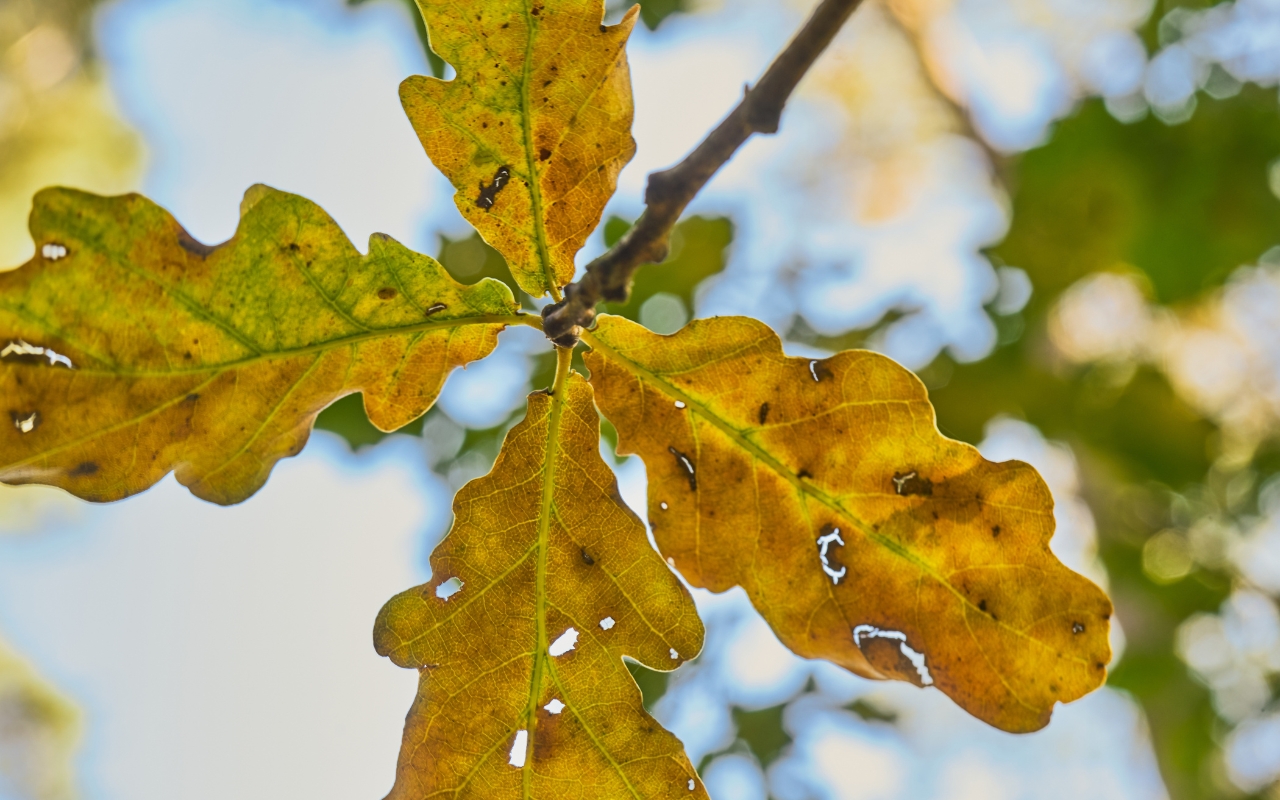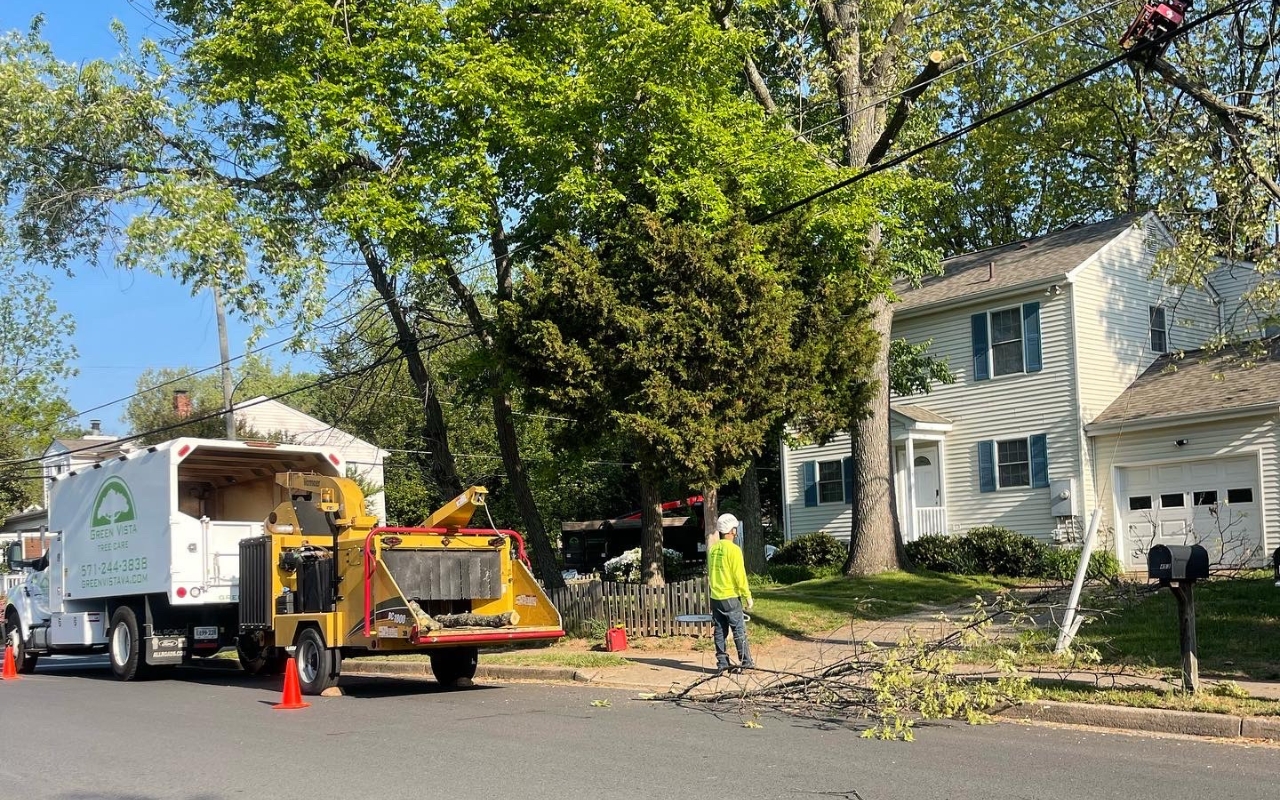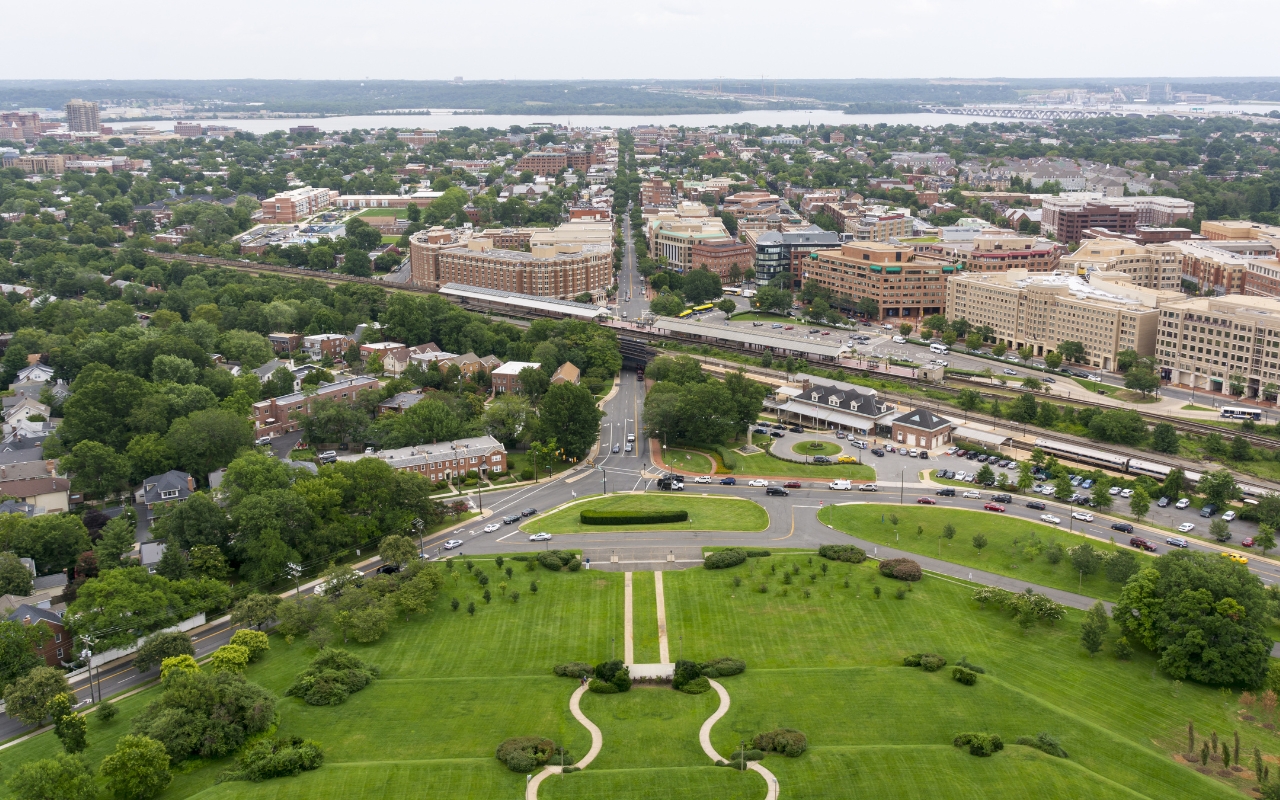If you’ve been watching your trees struggle through this summer’s heat waves across Northern Virginia, the transition between summer and fall brings both relief and concern. While cooler temperatures offer hope, this time of year also reveals the true extent of summer stress damage. From Arlington’s mature neighborhoods to Fairfax County’s established developments, homeowners are asking the same critical question: “Will my trees survive?”
The symptoms you’re seeing now – yellowing leaves, branch dieback, and premature leaf drop – tell a story about your tree’s current health. Understanding what these signs mean can help you determine whether your trees need immediate professional intervention or will recover naturally.
Key Takeaways
- Late summer reveals which trees can recover from heat stress and which need immediate professional intervention to survive winter.
- Summer stress may manifest differently in trees depending on their species and location in Northern Virginia.
- Specific warning signs separate normal seasonal changes from dangerous decline – including leaf patterns, bark condition, and branch flexibility.
- Early intervention during September’s cooler weather provides the best chance for stressed trees to recover before winter dormancy.
- Professional assessment is critical for trees showing multiple stress symptoms – some can recover with proper care, others pose safety risks and require removal.
Why Late Summer and Early Fall Reveal Tree Stress
Trees don’t usually fail during the hottest days of July – they hang on, using stored energy to get through. In late summer and early fall, those symptoms start to show. Leaves turn yellow too soon, branches die back, or trees shed foliage unevenly. These signs are often the first indication that a tree’s reserves are depleted after months of stress.
Cumulative Heat Stress Finally Shows Its Impact
Summer heat damage doesn’t happen overnight – it builds progressively through the growing season. Each day above 90°F forces trees to prioritize survival over growth, drawing from stored energy reserves to maintain basic functions. By late summer, trees may suddenly display dramatic symptoms as their energy reserves reach critical depletion levels.
This cumulative effect explains why trees across Northern Virginia neighborhoods are showing stress symptoms now, even with cooler weather. The damage occurred gradually over the summer months, but September and October’s natural transition period makes these problems impossible to ignore. Trees begin shutting down non-essential functions, and the results become starkly apparent in leaf color, branch condition, and overall canopy health.
Trees along east-west-oriented streets are particularly likely to show severe stress symptoms, as these locations created the most challenging conditions throughout the summer months.
Natural Transition Period Highlights Problems
September marks the beginning of trees’ preparation for winter dormancy, a process that requires significant energy reserves. Healthy trees transition smoothly into this phase, gradually changing leaf colors and dropping leaves in an orderly fashion. Stressed trees, however, cannot manage this transition properly.
The contrast becomes dramatic: healthy trees display the beautiful fall colors Northern Virginia is known for, while stressed trees show premature yellowing, sudden leaf drop, or branches that remain stubbornly green when they should be changing. This natural biological process essentially sorts trees into “survivors” and “struggling,” making late summer and early fall the ideal time for homeowners to assess their landscape.

Oak leaves display characteristic heat stress symptoms, including premature yellowing and brown edges.
Why Some Trees Appear Stressed and Others Look Fine
The environmental conditions along major corridors throughout the region create distinctly different microclimates from nearby residential streets, with patterns that repeat from Arlington’s urban core to Fairfax County’s suburban developments.
Urban Heat Island Effects Throughout the Region
Major thoroughfares throughout Northern Virginia all demonstrate similar heat island effects. Wide pavement surfaces act like massive solar collectors, absorbing heat throughout the day and radiating it well into the evening. This pattern means trees never get the nighttime cooling period they need for recovery. Temperature measurements indicate that these pavements can reach 140°F on sunny summer days, resulting in root zone temperatures that stress even the most heat-tolerant trees.
Traffic Impact on Regional Tree Health
Heavy traffic along Northern Virginia’s major arteries adds consistent stress layers beyond just heat. Vehicle exhaust contains compounds that damage leaf tissue, while constant air turbulence from passing traffic increases moisture loss through transpiration. Whether it’s the Beltway corridors or local thoroughfares, the combination of chemical stress and physical air movement amplifies heat stress effects on roadside trees throughout the region.
Soil and Drainage Challenges Across Urban Corridors
Years of traffic vibration and road salt application have compacted soils along major routes throughout Northern Virginia, reducing our trees’ ability to access water and nutrients. Poor drainage in compacted soils also means that when heavy rains do occur, water runs off rather than soaking in, where tree roots can access it. This creates a cycle where trees can’t recover even when conditions temporarily improve – a pattern repeated along east-west corridors throughout the region.

Professional tree care becomes essential when heat stress compromises tree health and safety.
What’s Normal and What’s Not for Virginia Trees
From the mature neighborhoods of Arlington and Alexandria to the suburban developments of Fairfax County, certain tree species are displaying consistent stress patterns. The effects are most visible along major east-west corridors, but even residential side streets are showing concerning symptoms as summer heat persists.
Red Maples: Regional Yellowing and Early Leaf Drop Patterns
Red maples, common throughout Northern Virginia’s older neighborhoods, are showing dramatic early yellowing across the region. Instead of the brilliant greens and reds these trees are known for, many are displaying pale yellow or even brown leaves by early September. This premature color change isn’t autumn beauty – it’s a distress signal. Red maples are particularly vulnerable because their shallow root systems can’t access deeper groundwater during extended heat periods, a problem amplified in urban and suburban settings.
Oak Trees: Widespread Canopy Dieback
The mature white and red oaks that give character to communities from Reston to Burke are experiencing what we call crown dieback. The center and upper portions of canopies show brown, brittle branches, while the lower, more shaded areas remain green. This pattern repeats across the region wherever trees are subjected to prolonged heat exposure. Left untreated, this dieback will continue spreading throughout the tree.
Other Common Ornamental Trees Under Regional Stress
Dogwood trees throughout the region, typically among the first to show fall color, are dropping leaves prematurely without their characteristic color display. Cherry trees in communities from Vienna to Springfield are showing similar stress patterns, with many developing sunscald on bark where they face prolonged western exposure. These ornamental species, popular throughout Northern Virginia’s residential areas, simply weren’t designed for the extended heat exposure that major corridors create.
Why Professional Assessment and Care Are Necessary
By late summer and early fall, heat stress symptoms are at their clearest — but what you see above ground doesn’t always tell the full story. Yellowing leaves, thinning canopies, and early leaf drop can signal hidden problems in the roots or trunk that only a trained arborist can properly diagnose.
Getting a professional tree health assessment now is critical. Trees already under stress face an uphill battle heading into winter, and waiting until colder weather sets in often means missing the best window for recovery.
Homeowners can’t solve these problems on their own — specialized tools, treatments, and expertise are needed to reduce stress and stabilize trees. Without professional care, many trees decline past the point of saving, leading to costly removals and a loss of shade and property value.
EXPERT INSIGHT: “Late summer and early fall are when summer’s hidden damage becomes obvious. Trees that looked fine in July suddenly show extensive problems because their energy reserves are finally exhausted. We can often save these trees with immediate intervention, but waiting until October or November significantly reduces success rates.” – Daniel Foster, Green Vista Founder and CEO

Urban development patterns contribute to microclimate challenges for roadside trees.
Recovery Strategies for Heat-Stressed Trees Across Northern Virginia
While summer heat stress is serious throughout the region, many trees can recover with proper care and professional intervention. The key is acting quickly before winter dormancy sets in, whether you’re dealing with stressed trees along major corridors or in residential settings.
Immediate Assessment Techniques
Before implementing any treatment strategy, it’s crucial to accurately assess the extent of heat damage. Professional Arborists use specific techniques to evaluate tree health, including testing for cambium vitality and assessing root zone conditions. Homeowners can perform basic checks, but a professional assessment is recommended for trees showing significant stress symptoms.
Proper Watering for Late Summer Conditions
Late summer and early fall watering requires a different approach than irrigation in the dog days of summer. Deep, infrequent watering works best, which means applying 1-2 inches of water weekly, soaking the entire root zone out to the tree’s drip line. Avoid frequent shallow watering that encourages surface root growth and makes trees more vulnerable to future heat stress. Early morning watering minimizes evaporation loss and reduces disease risk.
Soil Improvement Before Winter
Fall is the ideal time to improve soil conditions around heat-stressed trees. Organic matter additions, proper mulching, and soil aeration can significantly improve a tree’s ability to recover over winter and resist future heat stress. However, avoid fertilization of severely stressed trees, as this can actually increase stress levels.
Professional Intervention
Trees showing more than 25% canopy dieback, extensive leaf yellowing, or structural issues require immediate professional attention. Some heat-stressed trees may need careful pruning to remove dead branches and reduce overall stress load. Others may require more intensive treatments or, in severe cases, removal for safety reasons.
IMPORTANT: While removing dead branches from heat-stressed trees is often necessary, major pruning during summer months can actually increase stress levels and should only be performed by Certified Arborists who understand proper timing and techniques.
Emergency tree services become critical when heat stress compromises tree structural integrity.
Frequently Asked Questions
How much heat can mature oak trees withstand?
Mature oaks typically begin experiencing stress when temperatures exceed 90°F for extended periods. However, cumulative stress from multiple heat waves, combined with factors like poor soil or limited water access, can cause problems at lower temperatures.
Why are my tree leaves turning yellow in late summer?
Trees yellowing in late summer may indicate heat stress rather than normal fall color change. Heat-stressed trees may yellow prematurely as they shed leaves to conserve water and energy resources.
What temperature is too hot for established trees?
While established trees can tolerate brief periods above 100°F, sustained temperatures above 95°F combined with high humidity create dangerous conditions. The cumulative effect over multiple days is more damaging than single-day temperature spikes.
When should I call an arborist for heat stress assessment?
Contact a professional arborist immediately if you notice significant leaf yellowing, branch dieback, wilting that doesn’t recover overnight, or any structural concerns. Early intervention provides the best chance for tree recovery.
Don’t Leave Heat-Stressed Trees Vulnerable This Fall – Call Green Vista Tree Care
The challenges facing trees along major corridors represent broader issues affecting properties throughout Arlington, Alexandria, and Fairfax County. As Northern Virginia’s leading tree care professionals, Green Vista Tree Care has been helping homeowners across the region protect their valuable trees for over 15 years.
Our ISA Certified Arborists understand the diverse microclimate challenges throughout Northern Virginia and have developed proven strategies for helping heat-stressed trees recover. From urban Arlington corridors to suburban Fairfax County neighborhoods, we’ve seen how location-specific factors affect tree health, and we know how to address them effectively.
Call Green Vista Tree Care at 571-244-3838 or request a complimentary assessment online. Our regional expertise ensures your trees get the professional care they deserve.
Get helpful tips, local news, inspiring stories, and more delivered right to your inbox every month. Don't miss another issue - join today!





